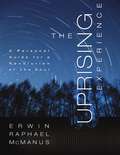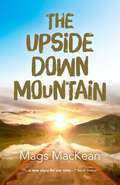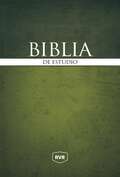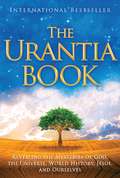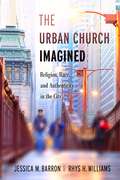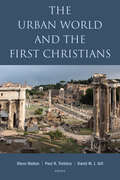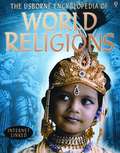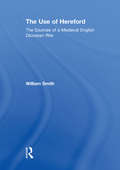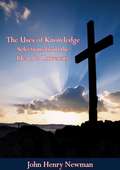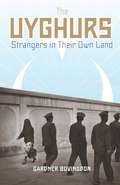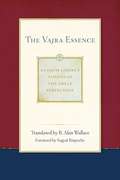- Table View
- List View
The Uprising Experience: A Personal Guide for a Revolution of the Soul, Promise Keepers Edition
by Erwin Raphael McmanusYou were born in God's imagination before you were ever conceived. All the talent, gifting, and creativity you possess was placed in you by God Himself. Can you imagine the things you could do, the impact you could have on the world, if you tapped into the dreams God has for your life? In The Uprising Experience, a companion workbook to Uprising, Erwin Raphael McManus invites readers to join a revolution of the soul. With interactive exercises, probing questions, and space for creative reflection, he helps readers to find their true purpose and destiny in the pursuit of God. He invites them to be part of a radical revolt that changes a life of imitation and mediocrity to one of passion and character.
The Upside Down Mountain
by Mags MacKeanWhat happens when you seem to have it all - enough money, health and success - but happiness remains elusive? The Upside Down Mountain forsakes the summit for the journey downhill, penetrating the hidden depths of darkness and discomfort most people live to avoid. This descent through the wild landscapes of the Pyrenees, the Amazon, Tibet and Egypt reveals how to navigate troubled times and create a new story for ourselves and the world: inspiring us to become the change we seek. Archetypal guardians become familiar allies at the thresholds of descent - pointing the way to deepening and lasting transformation. The narrative reads as an adventure yarn, and inspirational memoir, with implicit signposts for fellow explorers determined to lead a fulfilling life.
The Upside of Adversity
by Os HillmanHere, he explains how God uses adversity to show His power and purpose. Os identifies seven reasons people experience adversity, and the three stages of response—including practical ways to cope when circumstances veer out of control. You’ll see why some people become victims while others become victors.
The Upside of Down: Finding Hope When It Hurts
by Joseph M. StowellHave you ever found yourself caught on a roller-coaster ride that you weren't standing in line for? If so, you'll appreciate the way that author Joe Stowell reminds you of the important truths you need to know that will help you hold on with certainty and stay on board, even in the ups, downs, and wild curves of pain and suffering. The difference between a roller-coaster ride and trouble is clear. If we want to ride a roller coaster, we stand in line, eagerly waiting to enjoy the thrill; but trouble comes to us all, whether it takes the form of the death of a loved one, an illness, the untimely loss of a job, or the sudden break-up of a marriage. It's a "ride" that we would rather avoid, and none of us eagerly stands in line for it. In The Upside of Down, Dr. Stowell presents tribulation as God's tool to prepare Christians for His use. Citing numerous passages of Scripture and the personal experiences of Christians who have suffered, Stowell explains that ordeals will come, but we can respond productively in the midst of trouble if we remember that there is an ultimate purpose behind our suffering and that the "end of the ride is God's responsibility."
The Upside-Down Frown and Splashes of Joy
by Barbara JohnsonJoy and the Geranium Lady use gifts and the sharing of God's love to brighten the lives of people on a sad and gloomy street. Includes a suggestion of how to create a paper splash of joy featuring colorful beads and pictures.
The Upstairs Wife
by Rafia ZakariaA memoir of Karachi through the eyes of its women An Indies Introduce Debut Authors Selection For a brief moment on December 27, 2007, life came to a standstill in Pakistan. Benazir Bhutto, the country's former prime minister and the first woman ever to lead a Muslim country, had been assassinated at a political rally just outside Islamabad. Back in Karachi--Bhutto's birthplace and Pakistan's other great metropolis--Rafia Zakaria's family was suffering through a crisis of its own: her Uncle Sohail, the man who had brought shame upon the family, was near death. In that moment these twin catastrophes--one political and public, the other secret and intensely personal--briefly converged. Zakaria uses that moment to begin her intimate exploration of the country of her birth. Her Muslim-Indian family immigrated to Pakistan from Bombay in 1962, escaping the precarious state in which the Muslim population in India found itself following the Partition. For them, Pakistan represented enormous promise. And for some time, Zakaria's family prospered and the city prospered. But in the 1980s, Pakistan's military dictators began an Islamization campaign designed to legitimate their rule--a campaign that particularly affected women's freedom and safety. The political became personal when her aunt Amina's husband, Sohail, did the unthinkable and took a second wife, a humiliating and painful betrayal of kin and custom that shook the foundation of Zakaria's family but was permitted under the country's new laws. The young Rafia grows up in the shadow of Amina's shame and fury, while the world outside her home turns ever more chaotic and violent as the opportunities available to post-Partition immigrants are dramatically curtailed and terrorism sows its seeds in Karachi. Telling the parallel stories of Amina's polygamous marriage and Pakistan's hopes and betrayals, The Upstairs Wife is an intimate exploration of the disjunction between exalted dreams and complicated realities.From the Hardcover edition.
The Urantia Book
by Urantia FoundationYou have just discovered the literary masterpiece that answers your questions about God, life in the inhabited universe, the history and future of this world, and the life of Jesus. The Urantia Book harmonizes history, science, and religion into a philosophy of living that brings new meaning and hope into your life. If you are searching for answers, read The Urantia Book!The world needs new spiritual truth that provides modern men and women with an intellectual pathway into a personal relationship with God. Building on the world's religious heritage, The Urantia Book describes an endless destiny for humankind, teaching that living faith is the key to personal spiritual progress and eternal survival. These teachings provide new truths powerful enough to uplift and advance human thinking and believing for the next 1000 years.A third of The Urantia Book is the inspiring story of Jesus' entire life and a revelation of his original teachings. This panoramic narrative includes his birth, childhood, teenage years, adult travels and adventures, public ministry, crucifixion, and 19 resurrection appearances. This inspiring story recasts Jesus from the leading figure of Christianity into the guide for seekers of all faiths and all walks of life.
The Urban Church Imagined: Religion, Race, and Authenticity in the City
by Rhys H. Williams Jessica M. BarronExplores the role of race and consumer culture in attracting urban congregants to an evangelical church The Urban Church Imagined illuminates the dynamics surrounding white urban evangelical congregations’ approaches to organizational vitality and diversifying membership. Many evangelical churches are moving to urban, downtown areas to build their congregations and attract younger, millennial members. The urban environment fosters two expectations. First, a deep familiarity and reverence for popular consumer culture, and second, the presence of racial diversity. Church leaders use these ideas when they imagine what a “city church” should look like, but they must balance that with what it actually takes to make this happen. In part, racial diversity is seen as key to urban churches presenting themselves as “in touch” and “authentic.” Yet, in an effort to seduce religious consumers, church leaders often and inadvertently end up reproducing racial and economic inequality, an unexpected contradiction to their goal of inclusivity. Drawing on several years of research, Jessica M. Barron and Rhys H. Williams explore the cultural contours of one such church in downtown Chicago. They show that church leaders and congregants’ understandings of the connections between race, consumer culture, and the city is a motivating factor for many members who value interracial interactions as a part of their worship experience. But these explorations often unintentionally exclude members along racial and classed lines. Indeed, religious organizations’ efforts to engage urban environments and foster integrated congregations produce complex and dynamic relationships between their racially diverse memberships and the cultivation of a safe haven in which white, middle-class leaders can feel as though they are being a positive force in the fight for religious vitality and racial diversity. The book adds to the growing constellation of studies on urban religious organizations, as well as emerging scholarship on intersectionality and congregational characteristics in American religious life. In so doing, it offers important insights into racially diverse congregations in urban areas, a growing trend among evangelical churches. This work is an important case study on the challenges faced by modern churches and urban institutions in general.
The Urban Myths of Popular Modern Atheism: How Christian Faith Can Be Intelligent
by Paul E. HillHow Atheists rely on urban myths about religion to buttress their case against God. God, and the whole business of being dependent upon him, is being downgraded, downsized, downplayed, and most of all, just plain dismissed in the modern, cultured, educated parts of Europe and in academia. This process is powered and driven by a whole, growing series of interlocked urban myths about what is supposed to be involved in being a religious (and often specifically Christian) believer. This book examines and critiques those myths, showing how the Christian faith can be intelligent and supported by reason.
The Urban World and the First Christians
by Steve Walton Paul Trebilco David W. GillIn the tradition of The First Urban Christians by Wayne Meeks, this book explores the relationship between the earliest Christians and the city environment. Experts in classics, early Christianity, and human geography analyze the growth, development, and self-understanding of the early Christian movement in urban settings. The book's contributors first look at how the urban physical, cultural, and social environments of the ancient Mediterranean basin affected the ways in which early Christianity progressed. They then turn to how the earliest Christians thought and theologized in their engagement with cities. With a rich variety of expertise and scholarship, The Urban World and the First Christians is an important contribution to the understanding of early Christianity.
The Urban World and the First Christians
by Steve Walton Paul Trebilco David W. GillIn the tradition of The First Urban Christians by Wayne Meeks, this book explores the relationship between the earliest Christians and the city environment. Experts in classics, early Christianity, and human geography analyze the growth, development, and self-understanding of the early Christian movement in urban settings. The book's contributors first look at how the urban physical, cultural, and social environments of the ancient Mediterranean basin affected the ways in which early Christianity progressed. They then turn to how the earliest Christians thought and theologized in their engagement with cities. With a rich variety of expertise and scholarship, The Urban World and the First Christians is an important contribution to the understanding of early Christianity.
The Usborne Encyclopedia of World Religions: Internet-linked
by Susan Meredith Clare HickmanThe book will help readers gain an understanding of what people of different faiths believe, where and how people worship, the impact of religion on society, rites of passage, custom and festivals.
The Use and Abuse of the Spirit in Pentecostalism: A South African Perspective (Routledge New Critical Thinking in Religion, Theology and Biblical Studies)
by Mookgo S. Kgatle Allan H. AndersonThis book is a pneumatological reflection on the use and abuse of the Spirit in light of the abuse of religion within South African Pentecostalism. Both emerging and well-established scholars of South African Pentecostalism are brought together to reflect on pneumatology from various approaches, which includes among others: historical, biblical, migration, commercialisation of religion, discernment of spirits and human flourishing. From a broader understanding of the function of the Holy Spirit in different streams of Pentecostalism, the argument is that this function has changed with the emergence of the new Prophetic churches in South Africa. This is a fascinating insight into one of the major emerging worldwide religious movements. As such, it will be of great interest to academics in Pentecostal Studies, Christian Studies, Theology, and Religious Studies as well as African Studies and the Sociology of Religion.
The Use of Hereford: The Sources of a Medieval English Diocesan Rite
by William SmithThe Use of Hereford, a local variation of the Roman rite, was one of the diocesan liturgies of medieval England before their abolition and replacement by the Book of Common Prayer in 1549. Unlike the widespread Use of Sarum, the Use of Hereford was confined principally to its diocese, which helped to maintain its individuality until the Reformation. This study seeks to catalogue and evaluate all the known surviving sources of the Use of Hereford, with particular reference to the missals and gradual, which so far have received little attention. In addition to these a variety of other material has been examined, including a number of little-known or unknown important fragments of early Hereford service-books dismembered at the Reformation and now hidden away as binding or other scrap in libraries and record offices. This is the fullest examination of Hereford liturgical sources ever undertaken and may stimulate similar and much-needed studies of other diocesan uses, in particular Sarum and York. As well as describing in detail the various manuscript sources, the rare single edition printed Hereford texts, the missals and breviaries, are also discussed. Unlike books of the Sarum and York rites, these ’one-offs’ were never revised and reissued. In addition to the examination of these sources, William Smith discusses the possible origins of the rite and provides an analysis of the Hereford liturgical calendar, of the festa, including those of the cathedral’s patron St Ethelbert and the no less famous St Thomas Cantilupe, that helped to make Hereford use so distinctive.
The Use of Philosophy: Californian Addresses (Routledge Revivals)
by John H MuirheadFirst published in 1928, this book reproduces the lectures and addresses that John Henry Muirhead gave on various occasions during the two and a half years he spent as Lecturer of Philosophy on the Mills Foundation at the University of California, USA. The different chapters look at the meaning and general place of Philosophy as a subject of study and the application of its leading conceptions to different areas of modern life, including science and politics. The final chapters however, present two short talks of a different nature, which were addressed to Scottish countrymen, gathered on foreign shores. This book outlines Muirhead's philosophical thoughts and conclusions to which he devoted his life.
The Usefulness of Scripture: Essays in Honor of Robert W. Wall
by Daniel Castelo Sara M. Koenig David R. NienhuisRobert Wall began his teaching career at Seattle Pacific University in 1978. Now, forty years later and in celebration of his seventieth birthday, colleagues and former students have gathered to produce this volume in honor of their friend and teacher. The results are sure to delight all of those who have studied under or been friends of Professor Wall.The essays are grouped under two general themes: theology and methodology (with an emphasis on Wesleyan biblical hermeneutics, canonical perspectives, and the implications of these approaches for church life and work) and biblical texts/themes, especially with a view to the relationship of the study of Scripture to the life of the Christian. In both of these areas, the contributions bear in mind Wall’s conviction that academic study and spiritual life need not—in fact, should not—be kept apart.The contributors to this volume include Frank Anthony Spina, Andrew Knapp, Shannon Nicole Smythe, Daniel Castelo, Anthony B. Robinson, Eugene E. Lemcio, Sara M. Koenig, Jack Levison, Laura C. S. Holmes, John Painter, and Stephen E. Fowl.
The User's Guide to Spiritual Teachers
by Scott EdelsteinA wise and practical quickstart guide for anyone who wants—or already has—a spiritual teacher. The User’s Guide to Spiritual Teachers is a necessary book for anyone who has, or wants to have, a spiritual teacher—regardless of faith or tradition. This book addresses concerns that many of us have on the spiritual path, including how to find a spiritual teacher, how to manage expectations about what they can do, and what to do when you realize you’re in a dangerous relationship with one. Spiritual teachers of all traditions will themselves find this book incredibly useful as they reflect on how they benefit their students or may be overstepping their boundaries and actually creating harm. This is your place to look for information, inspiration, sanity, and words of caution.
The Uses of Knowledge Selections from the Idea of a University
by John Henry NewmanThis insightful selection, features four discourses from The Idea of a University: Knowledge Its Own End; Knowledge Viewed in Relation to Learning; Knowledge Viewed in Relation to Professional Skill; and Knowledge Viewed in Relation to Religion. Also included are excerpts from the "Preface" and the following appendices: Discipline of Mind; Literature and Science; and Style. Edited by Leo L. Ward, this volume also contains an introduction, a list of principal dates in Newman's life, and a bibliography.
The Uses of Paradox: Religion, Self-Transformation, and the Absurd
by Matthew C. BaggerIn this groundbreaking comparative study, Matthew Bagger investigates the role of paradox in Western and Asian religious discourse. Drawing on both philosophy and social scientific theory, he offers a naturalistic explanation of religion's oft-noted propensity to sublime paradox and argues that religious thinkers employ intractable paradoxes as the basis for various techniques of self-transformation. Considering the writings of Kierkegaard, Pseudo-Dionysus, St. John of the Cross, N?g?rjuna, and Chuang-tzu, among others, Bagger identifies two religious uses of paradox: cognitive asceticism, which wields the psychological discomfort of paradox as an instrument of self-transformation, and mysticism, which seeks to transform the self through an alleged extraordinary cognition that ineffably comprehends paradox. Bagger contrasts these techniques of self-transformation with skepticism, which cultivates the appearance of contradiction in order to divest a person of beliefs altogether. Bagger further contends that a thinker's social attitudes determine his or her response to paradox. Attitudes concerning crossing the boundary of a social group prefigure attitudes concerning supposed truths that lie beyond the boundaries of understanding. Individuals who fear crossing the boundary of their social group and would prohibit them tend to use paradox ascetically, while individuals who find the controlled incorporation of outsiders enriching commonly find paradox revelatory. Although scholars have long noted that religious discourse seems to cultivate and perpetuate paradox, their scholarship tends to ratify religious attitudes toward paradox instead of explaining the unusual reaction paradox provokes. A vital contribution to discussions of mystical experience, The Uses of Paradox reveals how much this experience relies on social attitudes and cosmological speculation.
The Utimate Glow Up Guide: A Guide to Self Growth, Self Care, and Becoming the Best Version of You
by Elicia GoguenGlow Up Into A New, Empowered You#1 New Release in New ThoughtFind a deep understanding of how to have a glow up and what that truly means for women. Empowerment books like this are hard to find—become the best version of yourself today.How to have a glow up—made easy. Author Elicia Goguen, creator of The Glow Up Secrets YouTube channel, shares her personal glow-up journey and how to have a glow up yourself, giving tips on changing thoughts of self-hate or sabotage into self improvement for real women. No more indulging in body shaming or unhealthy diet culture while focusing on your outer appearance with this women’s empowerment book.Glow up from within. This shadow work book guides women back to their unique selves, healing their inner child along the way. Break unhealthy habits and relationships by connecting with your authentic self. Women can glow up with this self growth book for lasting change. It’s your time to start creating your story from a place of self acceptance and self love.In The Ultimate Glow Up Guide, discover:Ways to stop self hate, self criticism, and self limiting beliefs in this self confidence bookAn inner child healing book full of self care for womenHow to have a glow up on your way to achieving your dream lifeIf you liked books for women and empowerment books such as Badass Affirmations, Help Me, I'm Stuck, or How to Do the Work, you will love The Ultimate Glow Up Guide!
The Uttaratantra in the Land of Snows: Tibetan Thinkers Debate the Centrality of the Buddha-Nature Treatise
by Tsering WangchukWith its emphasis on the concept of buddha-nature, or the ultimate nature of mind, the Uttaratantra is a classical Buddhist treatise that lays out an early map of the Mahāyāna path to enlightenment. Tsering Wangchuk unravels the history of this important Indic text in Tibet by examining numerous Tibetan commentaries and other exegetical texts on the treatise that emerged between the eleventh and fifteenth centuries. These commentaries explored such questions as: Is the buddha-nature teaching found in the Uttaratantra literally true, or does it have to be interpreted differently to understand its ultimate meaning? Does it explicate ultimate truth that is inherently enlightened or ultimate truth that is empty only of independent existence? Does the treatise teach ultimate nature of mind according to the Cittamātra or the Madhyamaka School of Mahāyāna? By focusing on the diverse interpretations that different textual communities employed to make sense of the Uttaratantra, Wangchuk provides a necessary historical context for the development of the text in Tibet.
The Utter Relief of Holiness
by John EldredgeWhat a relief it would be to be set free from all that plagues us -- the inner struggle with anger, or contempt, the habitual sins. Is such an experience possible? John Eldredge believes it is, and in THE UTTER RELIEF OF HOLINESS, he shows readers how they can be that free, though the healing work of Christ in their lives. It begins when we discover what the salvation of Jesus Christ means for our own restoration and find that holiness is an expression of the healing of our humanity.Here is a book that explores the beauty of the genuine goodness available to us in Jesus Christ, and guides the reader through the process whereby God makes us whole and holy by his love. Readers will be relieved. Utterly.
The Utter Relief of Holiness: How God's Goodness Frees Us From Everything That Plagues Us
by John EldredgeDo you want to feel whole - but too often, feel pulled in different directions? Do you want to be holy - but think it's beyond you? We tend to associate holiness with striving and restriction - but what if a holy life were really about being set free from all our burdens? In THE UTTER RELIEF OF HOLINESS, John Eldredge teaches that, rather than being a daunting or distant ideal, holiness is in fact an expression of the healing of our humanity. Eldredge believes that we can be set free from all that plagues us - the inner struggle with anger, or contempt, or habitual sins - to find the genuine goodness that is available to us in Jesus Christ.Wise, gentle and rooted in the Bible, THE UTTER RELIEF OF HOLINESS guides the reader along the paths God leads us to make us whole and holy - by his love.
The Uyghurs: Strangers in Their Own Land
by Gardner BovingdonFor more than half a century many Uyghurs, members of a Muslim minority in northwestern China, have sought to achieve greater autonomy or outright independence. Yet the Chinese government has consistently resisted these efforts, countering with repression and a sophisticated strategy of state-sanctioned propaganda emphasizing interethnic harmony and Chinese nationalism. After decades of struggle, Uyghurs remain passionate about establishing and expanding their power within government, and China's leaders continue to push back, refusing to concede any physical or political ground.Beginning with the history of Xinjiang and its unique population of Chinese Muslims, Gardner Bovingdon follows fifty years of Uyghur discontent, particularly the development of individual and collective acts of resistance since 1949, as well as the role of various transnational organizations in cultivating dissent. Bovingdon's work provides fresh insight into the practices of nation building and nation challenging, not only in relation to Xinjiang but also in reference to other regions of conflict. His work highlights the influence of international institutions on growing regional autonomy and underscores the role of representation in nationalist politics, as well as the local, regional, and global implications of the "war on terror" on antistate movements. While both the Chinese state and foreign analysts have portrayed Uyghur activists as Muslim terrorists, situating them within global terrorist networks, Bovingdon argues that these assumptions are flawed, drawing a clear line between Islamist ideology and Uyghur nationhood.
The Vajra Essence
by B. Alan Wallace Dudjom LingpaA systematic presentation of the path of Dzogchen, the Great Perfection, by one of its most renowned proponents and rendered by a master translator.Düdjom Lingpa (1835–1904) was one of the foremost tantric masters of nineteenth-century Tibet, and his powerful voice resonates strongly among Buddhist practitioners today. The Vajra Essence is Düdjom Lingpa’s most extended meditation on the path of Great Perfection, in many senses a commentary on all his other Dzogchen works. Dzogchen, the pinnacle of practice in the Nyingma school, is a radical revelation of the pure nature of consciousness that is delivered from master to disciple and perfected in a meditation that permeates every moment of our experience. Revealed to Düdjom Lingpa as a visionary “treasure” text in 1862, the Vajra Essence takes the reader through seven stages of progressively deeper practice, from “taking the impure mind as the path” up to the practice of “direct crossing over” (tögal). The longest of Düdjom Lingpa’s five visionary works on Dzogchen, readers will find this a rich and masterful evocation of the enlightened experience. This is the first translation of this seminal work in any Western language, and B. Alan Wallace, with his forty-five-plus years of extensive learning and deep meditative experience, is one of the most accomplished translators of Tibetan texts into English.
